Operations Management Principles & PLC Project Analysis: Sainsbury's
VerifiedAdded on 2023/06/15
|15
|4444
|243
Report
AI Summary
This report provides a detailed analysis of Sainsbury's Plc's operations management, examining the implementation of key principles and methodologies such as Six Sigma and Lean principles. It includes a critique of their operational practices and proposes a continuous improvement plan to enhance efficiency and productivity within the organization. The report also applies each stage of the Project Lifecycle (PLC) to a given project, supported by necessary documentation, and analyzes the rationale for project methodologies, tools, and leadership within the PLC. Finally, it reviews the effectiveness of the PLC in the chosen project, utilizing appropriate theories, concepts, and models, offering a comprehensive evaluation of Sainsbury's operational strategies and project management approaches.
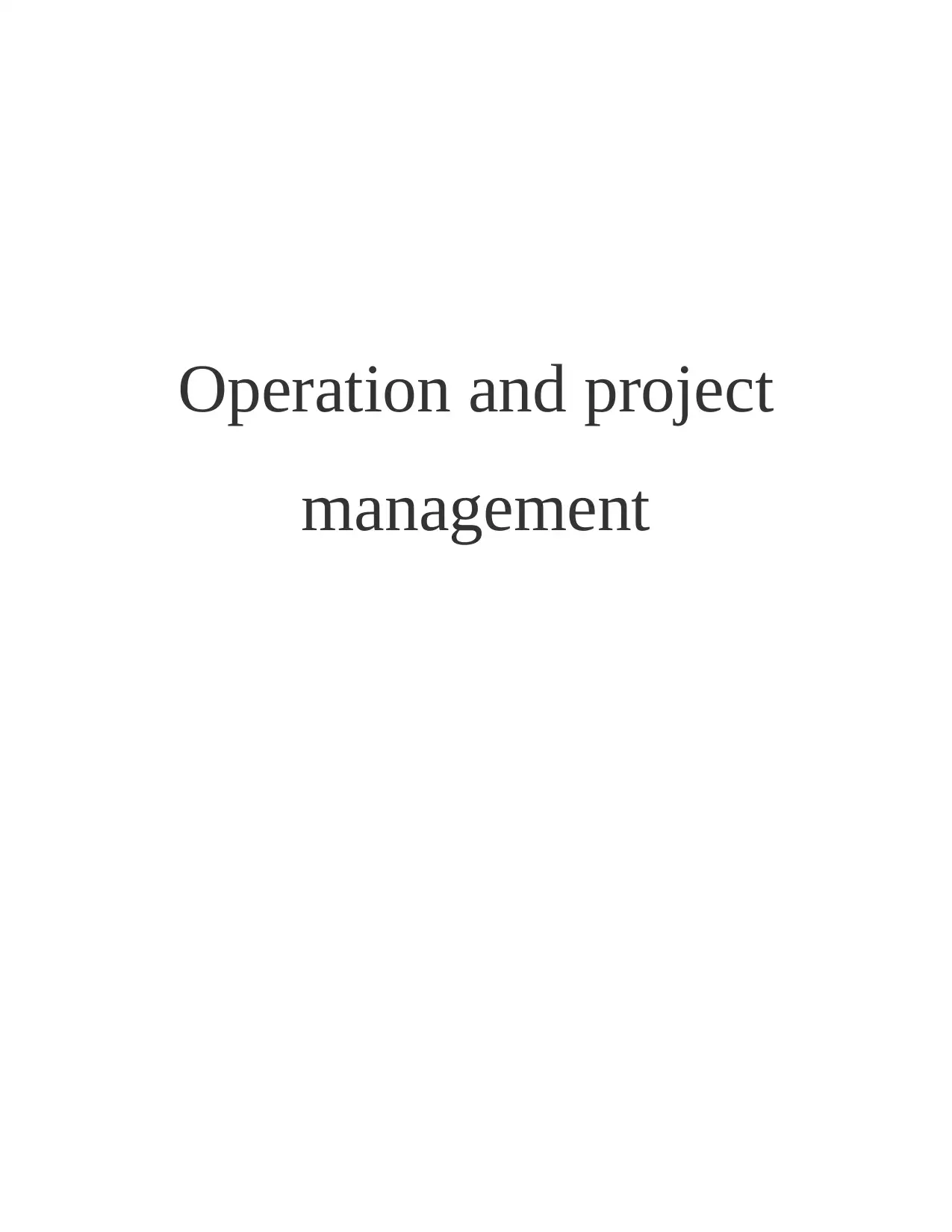
Operation and project
management
management
Paraphrase This Document
Need a fresh take? Get an instant paraphrase of this document with our AI Paraphraser
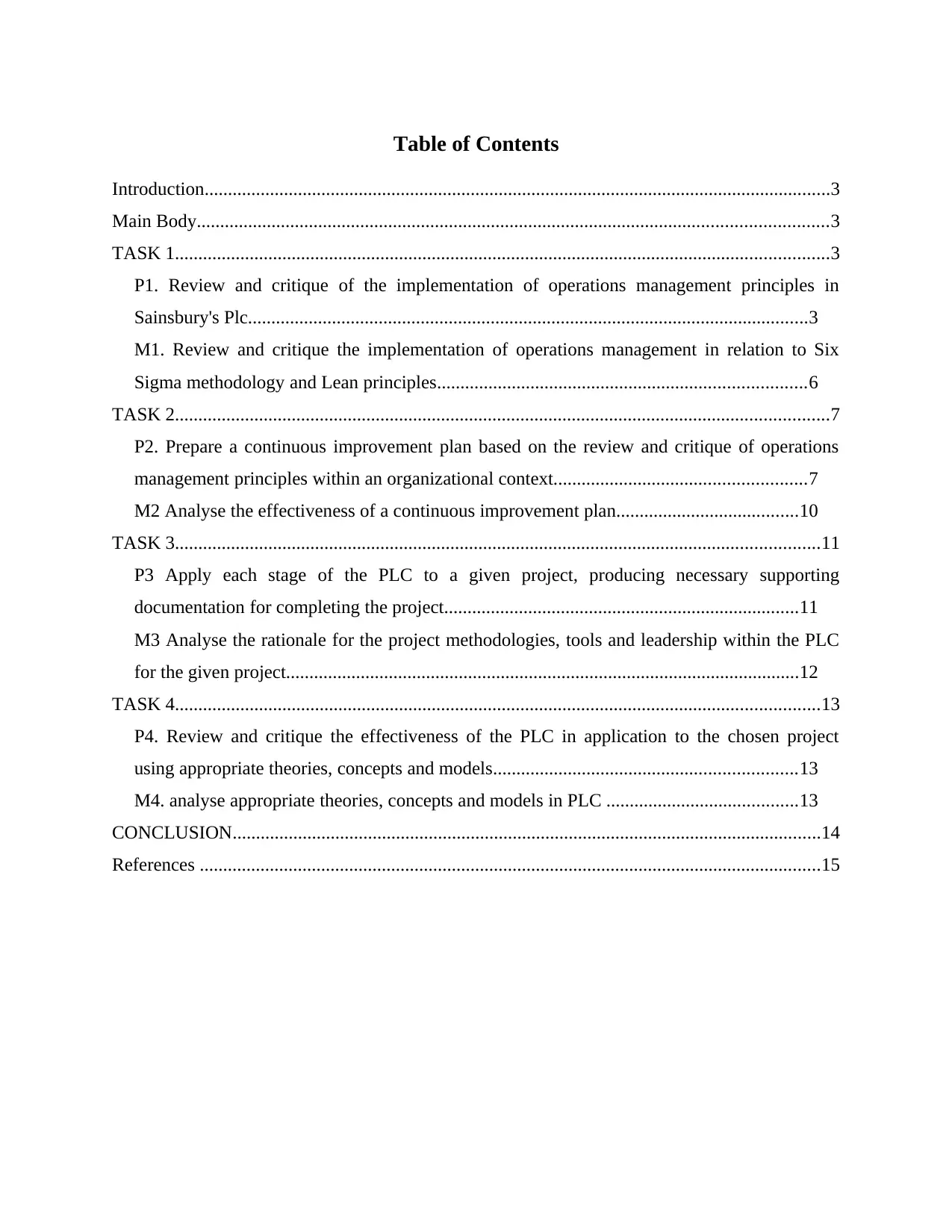
Table of Contents
Introduction......................................................................................................................................3
Main Body.......................................................................................................................................3
TASK 1............................................................................................................................................3
P1. Review and critique of the implementation of operations management principles in
Sainsbury's Plc........................................................................................................................3
M1. Review and critique the implementation of operations management in relation to Six
Sigma methodology and Lean principles...............................................................................6
TASK 2............................................................................................................................................7
P2. Prepare a continuous improvement plan based on the review and critique of operations
management principles within an organizational context......................................................7
M2 Analyse the effectiveness of a continuous improvement plan.......................................10
TASK 3..........................................................................................................................................11
P3 Apply each stage of the PLC to a given project, producing necessary supporting
documentation for completing the project............................................................................11
M3 Analyse the rationale for the project methodologies, tools and leadership within the PLC
for the given project..............................................................................................................12
TASK 4..........................................................................................................................................13
P4. Review and critique the effectiveness of the PLC in application to the chosen project
using appropriate theories, concepts and models.................................................................13
M4. analyse appropriate theories, concepts and models in PLC .........................................13
CONCLUSION..............................................................................................................................14
References .....................................................................................................................................15
Introduction......................................................................................................................................3
Main Body.......................................................................................................................................3
TASK 1............................................................................................................................................3
P1. Review and critique of the implementation of operations management principles in
Sainsbury's Plc........................................................................................................................3
M1. Review and critique the implementation of operations management in relation to Six
Sigma methodology and Lean principles...............................................................................6
TASK 2............................................................................................................................................7
P2. Prepare a continuous improvement plan based on the review and critique of operations
management principles within an organizational context......................................................7
M2 Analyse the effectiveness of a continuous improvement plan.......................................10
TASK 3..........................................................................................................................................11
P3 Apply each stage of the PLC to a given project, producing necessary supporting
documentation for completing the project............................................................................11
M3 Analyse the rationale for the project methodologies, tools and leadership within the PLC
for the given project..............................................................................................................12
TASK 4..........................................................................................................................................13
P4. Review and critique the effectiveness of the PLC in application to the chosen project
using appropriate theories, concepts and models.................................................................13
M4. analyse appropriate theories, concepts and models in PLC .........................................13
CONCLUSION..............................................................................................................................14
References .....................................................................................................................................15
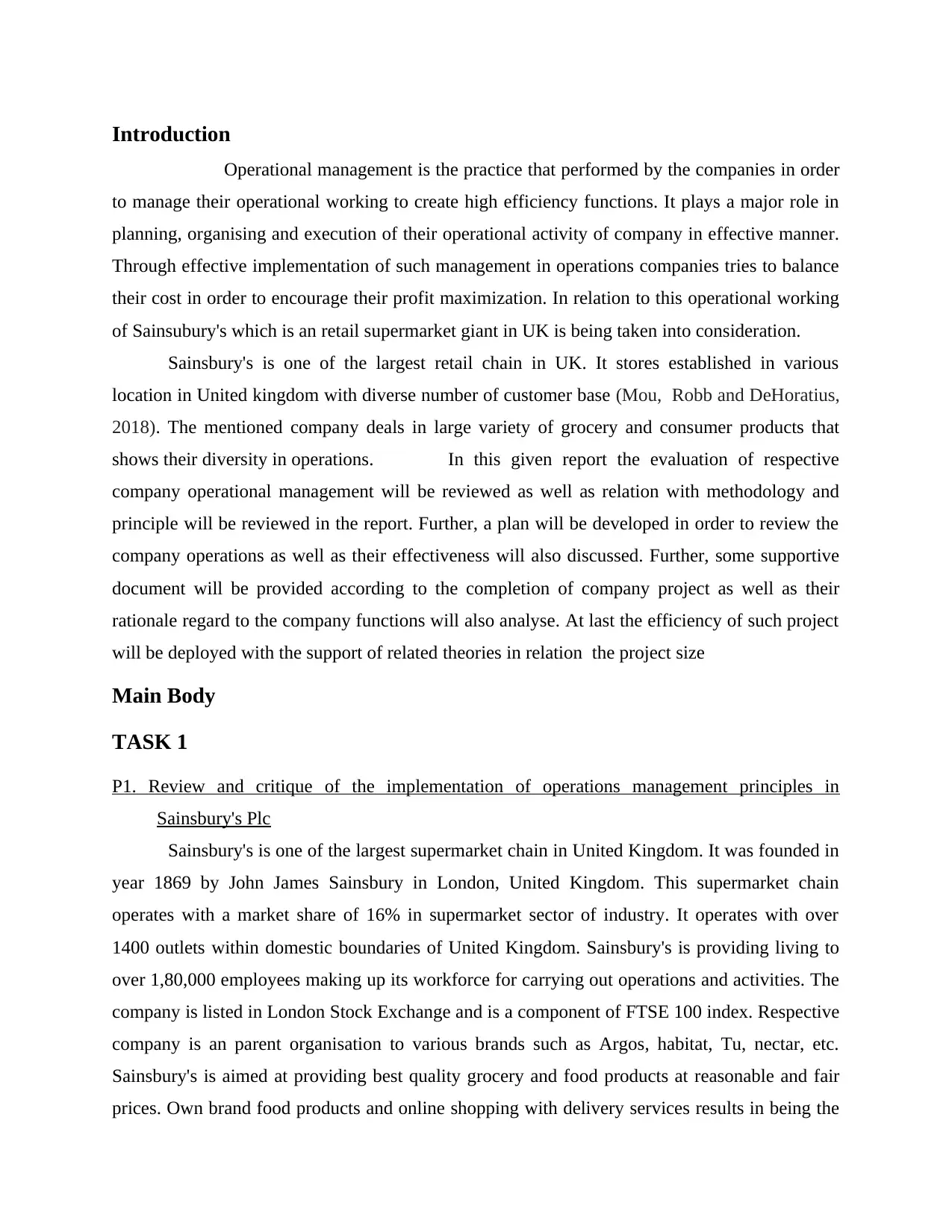
Introduction
Operational management is the practice that performed by the companies in order
to manage their operational working to create high efficiency functions. It plays a major role in
planning, organising and execution of their operational activity of company in effective manner.
Through effective implementation of such management in operations companies tries to balance
their cost in order to encourage their profit maximization. In relation to this operational working
of Sainsubury's which is an retail supermarket giant in UK is being taken into consideration.
Sainsbury's is one of the largest retail chain in UK. It stores established in various
location in United kingdom with diverse number of customer base (Mou, Robb and DeHoratius,
2018). The mentioned company deals in large variety of grocery and consumer products that
shows their diversity in operations. In this given report the evaluation of respective
company operational management will be reviewed as well as relation with methodology and
principle will be reviewed in the report. Further, a plan will be developed in order to review the
company operations as well as their effectiveness will also discussed. Further, some supportive
document will be provided according to the completion of company project as well as their
rationale regard to the company functions will also analyse. At last the efficiency of such project
will be deployed with the support of related theories in relation the project size
Main Body
TASK 1
P1. Review and critique of the implementation of operations management principles in
Sainsbury's Plc
Sainsbury's is one of the largest supermarket chain in United Kingdom. It was founded in
year 1869 by John James Sainsbury in London, United Kingdom. This supermarket chain
operates with a market share of 16% in supermarket sector of industry. It operates with over
1400 outlets within domestic boundaries of United Kingdom. Sainsbury's is providing living to
over 1,80,000 employees making up its workforce for carrying out operations and activities. The
company is listed in London Stock Exchange and is a component of FTSE 100 index. Respective
company is an parent organisation to various brands such as Argos, habitat, Tu, nectar, etc.
Sainsbury's is aimed at providing best quality grocery and food products at reasonable and fair
prices. Own brand food products and online shopping with delivery services results in being the
Operational management is the practice that performed by the companies in order
to manage their operational working to create high efficiency functions. It plays a major role in
planning, organising and execution of their operational activity of company in effective manner.
Through effective implementation of such management in operations companies tries to balance
their cost in order to encourage their profit maximization. In relation to this operational working
of Sainsubury's which is an retail supermarket giant in UK is being taken into consideration.
Sainsbury's is one of the largest retail chain in UK. It stores established in various
location in United kingdom with diverse number of customer base (Mou, Robb and DeHoratius,
2018). The mentioned company deals in large variety of grocery and consumer products that
shows their diversity in operations. In this given report the evaluation of respective
company operational management will be reviewed as well as relation with methodology and
principle will be reviewed in the report. Further, a plan will be developed in order to review the
company operations as well as their effectiveness will also discussed. Further, some supportive
document will be provided according to the completion of company project as well as their
rationale regard to the company functions will also analyse. At last the efficiency of such project
will be deployed with the support of related theories in relation the project size
Main Body
TASK 1
P1. Review and critique of the implementation of operations management principles in
Sainsbury's Plc
Sainsbury's is one of the largest supermarket chain in United Kingdom. It was founded in
year 1869 by John James Sainsbury in London, United Kingdom. This supermarket chain
operates with a market share of 16% in supermarket sector of industry. It operates with over
1400 outlets within domestic boundaries of United Kingdom. Sainsbury's is providing living to
over 1,80,000 employees making up its workforce for carrying out operations and activities. The
company is listed in London Stock Exchange and is a component of FTSE 100 index. Respective
company is an parent organisation to various brands such as Argos, habitat, Tu, nectar, etc.
Sainsbury's is aimed at providing best quality grocery and food products at reasonable and fair
prices. Own brand food products and online shopping with delivery services results in being the
⊘ This is a preview!⊘
Do you want full access?
Subscribe today to unlock all pages.

Trusted by 1+ million students worldwide
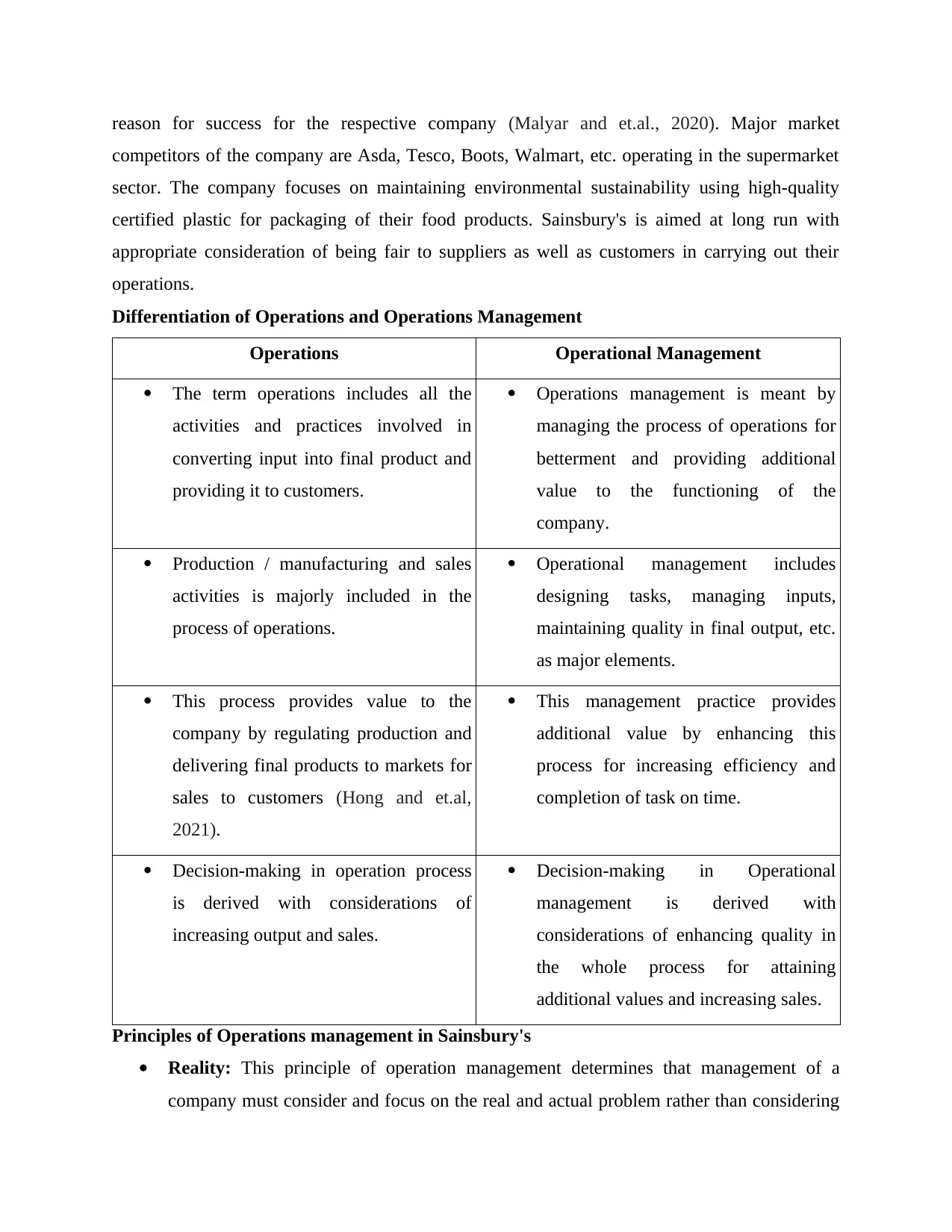
reason for success for the respective company (Malyar and et.al., 2020). Major market
competitors of the company are Asda, Tesco, Boots, Walmart, etc. operating in the supermarket
sector. The company focuses on maintaining environmental sustainability using high-quality
certified plastic for packaging of their food products. Sainsbury's is aimed at long run with
appropriate consideration of being fair to suppliers as well as customers in carrying out their
operations.
Differentiation of Operations and Operations Management
Operations Operational Management
The term operations includes all the
activities and practices involved in
converting input into final product and
providing it to customers.
Operations management is meant by
managing the process of operations for
betterment and providing additional
value to the functioning of the
company.
Production / manufacturing and sales
activities is majorly included in the
process of operations.
Operational management includes
designing tasks, managing inputs,
maintaining quality in final output, etc.
as major elements.
This process provides value to the
company by regulating production and
delivering final products to markets for
sales to customers (Hong and et.al,
2021).
This management practice provides
additional value by enhancing this
process for increasing efficiency and
completion of task on time.
Decision-making in operation process
is derived with considerations of
increasing output and sales.
Decision-making in Operational
management is derived with
considerations of enhancing quality in
the whole process for attaining
additional values and increasing sales.
Principles of Operations management in Sainsbury's
Reality: This principle of operation management determines that management of a
company must consider and focus on the real and actual problem rather than considering
competitors of the company are Asda, Tesco, Boots, Walmart, etc. operating in the supermarket
sector. The company focuses on maintaining environmental sustainability using high-quality
certified plastic for packaging of their food products. Sainsbury's is aimed at long run with
appropriate consideration of being fair to suppliers as well as customers in carrying out their
operations.
Differentiation of Operations and Operations Management
Operations Operational Management
The term operations includes all the
activities and practices involved in
converting input into final product and
providing it to customers.
Operations management is meant by
managing the process of operations for
betterment and providing additional
value to the functioning of the
company.
Production / manufacturing and sales
activities is majorly included in the
process of operations.
Operational management includes
designing tasks, managing inputs,
maintaining quality in final output, etc.
as major elements.
This process provides value to the
company by regulating production and
delivering final products to markets for
sales to customers (Hong and et.al,
2021).
This management practice provides
additional value by enhancing this
process for increasing efficiency and
completion of task on time.
Decision-making in operation process
is derived with considerations of
increasing output and sales.
Decision-making in Operational
management is derived with
considerations of enhancing quality in
the whole process for attaining
additional values and increasing sales.
Principles of Operations management in Sainsbury's
Reality: This principle of operation management determines that management of a
company must consider and focus on the real and actual problem rather than considering
Paraphrase This Document
Need a fresh take? Get an instant paraphrase of this document with our AI Paraphraser

a smaller part of that problem. It suggests that operations management must be applied in
an organisation for improving productivity and efficiency of company's operations for
conquering over the real and actual problem (Barnes, 2018).
Organisation: This principles of operations management determines interconnectedness
of all elements of an organisation with production process or operations. Operations
management must be applied in an organisation for maintaining consistency in efficient
management practices for increasing productivity and coordination.
Change: Efficient and effective operations management facilitates adaptation of change
in an organisation's operations for increasing effectiveness and efficiency. It suggests that
organisations must apply operations management for adapting various changes in the
dynamic market environment for betterment of operations.
Implementation of Operations Management in Sainsbury's
Supporting Company's strategies: Importance of operations lies in facilitating
company's core strategies in operating business activities and operations. For instance,
providing quality food at reasonable price is considered as primary strategy of
Sainsbury's. Implementation of efficient operations management will allow company in
reducing cost of production and providing quality products at fair and reasonable prices.
Therefore, it increases effectiveness and efficiency in carrying out operations of
Sainsbury's (Choi, Wallace and Wang , 2018).
Product Positioning: Another major aspect of applying operations management in
Sainsbury's is to develop products that stand out in the market with superior quality at
reasonable price. It ensures operations with green process which provides additional
value to company as well as environment. This aspect includes improvisation in product
detailing, pricing, appearance, quality, etc. for enhancing product's quality to differentiate
from other competitor's products.
Product Differentiation: Sainsbury's offers huge amount of consumer products for
various segments of people in society. This initiative allows serving people from all the
segments and achieve customer satisfaction. Efficient operations management will
facilitate product differentiation in Sainsbury's for serving different segments of society.
Various approaches to operations management
Different approaches of operations management used by Sainsbury's are as follows:
an organisation for improving productivity and efficiency of company's operations for
conquering over the real and actual problem (Barnes, 2018).
Organisation: This principles of operations management determines interconnectedness
of all elements of an organisation with production process or operations. Operations
management must be applied in an organisation for maintaining consistency in efficient
management practices for increasing productivity and coordination.
Change: Efficient and effective operations management facilitates adaptation of change
in an organisation's operations for increasing effectiveness and efficiency. It suggests that
organisations must apply operations management for adapting various changes in the
dynamic market environment for betterment of operations.
Implementation of Operations Management in Sainsbury's
Supporting Company's strategies: Importance of operations lies in facilitating
company's core strategies in operating business activities and operations. For instance,
providing quality food at reasonable price is considered as primary strategy of
Sainsbury's. Implementation of efficient operations management will allow company in
reducing cost of production and providing quality products at fair and reasonable prices.
Therefore, it increases effectiveness and efficiency in carrying out operations of
Sainsbury's (Choi, Wallace and Wang , 2018).
Product Positioning: Another major aspect of applying operations management in
Sainsbury's is to develop products that stand out in the market with superior quality at
reasonable price. It ensures operations with green process which provides additional
value to company as well as environment. This aspect includes improvisation in product
detailing, pricing, appearance, quality, etc. for enhancing product's quality to differentiate
from other competitor's products.
Product Differentiation: Sainsbury's offers huge amount of consumer products for
various segments of people in society. This initiative allows serving people from all the
segments and achieve customer satisfaction. Efficient operations management will
facilitate product differentiation in Sainsbury's for serving different segments of society.
Various approaches to operations management
Different approaches of operations management used by Sainsbury's are as follows:
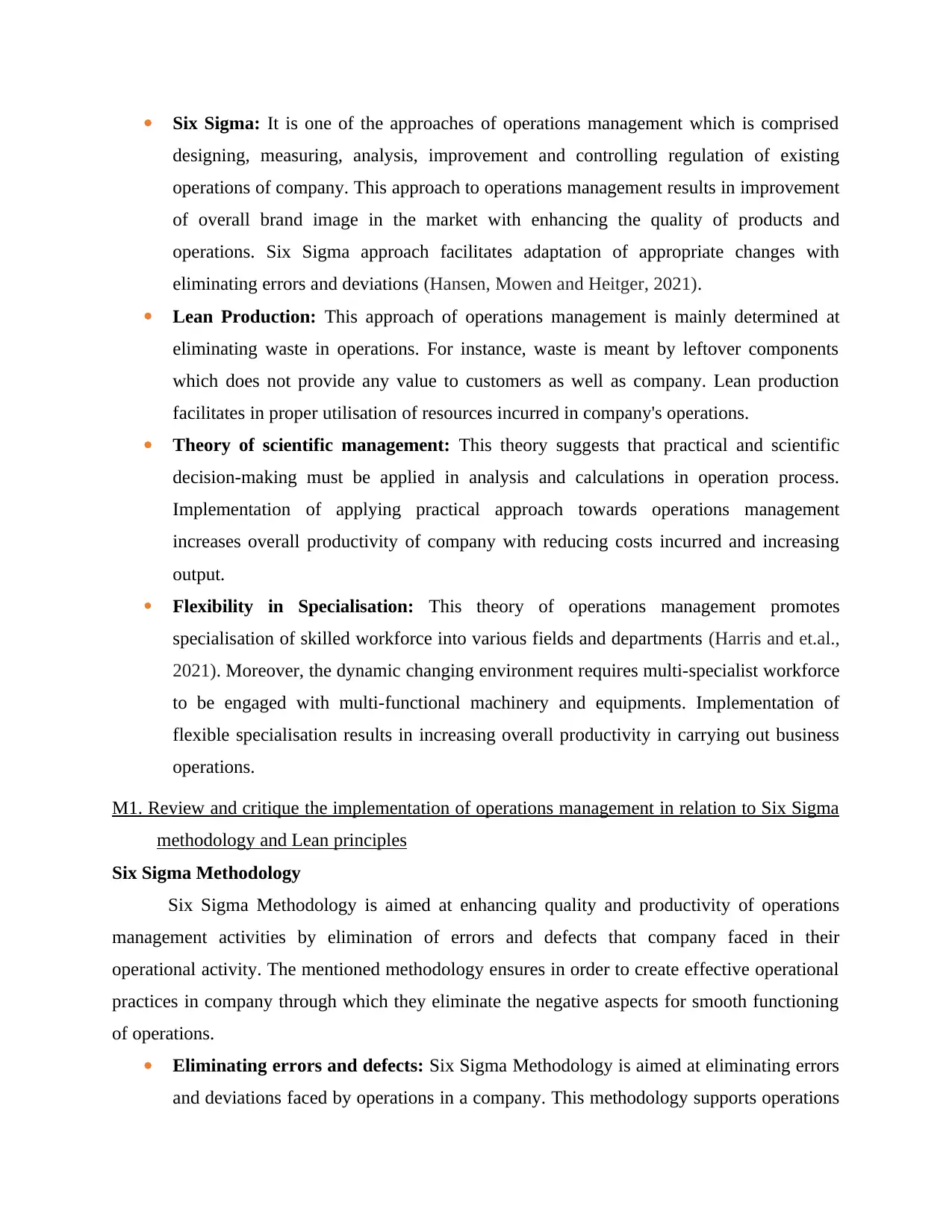
Six Sigma: It is one of the approaches of operations management which is comprised
designing, measuring, analysis, improvement and controlling regulation of existing
operations of company. This approach to operations management results in improvement
of overall brand image in the market with enhancing the quality of products and
operations. Six Sigma approach facilitates adaptation of appropriate changes with
eliminating errors and deviations (Hansen, Mowen and Heitger, 2021).
Lean Production: This approach of operations management is mainly determined at
eliminating waste in operations. For instance, waste is meant by leftover components
which does not provide any value to customers as well as company. Lean production
facilitates in proper utilisation of resources incurred in company's operations.
Theory of scientific management: This theory suggests that practical and scientific
decision-making must be applied in analysis and calculations in operation process.
Implementation of applying practical approach towards operations management
increases overall productivity of company with reducing costs incurred and increasing
output.
Flexibility in Specialisation: This theory of operations management promotes
specialisation of skilled workforce into various fields and departments (Harris and et.al.,
2021). Moreover, the dynamic changing environment requires multi-specialist workforce
to be engaged with multi-functional machinery and equipments. Implementation of
flexible specialisation results in increasing overall productivity in carrying out business
operations.
M1. Review and critique the implementation of operations management in relation to Six Sigma
methodology and Lean principles
Six Sigma Methodology
Six Sigma Methodology is aimed at enhancing quality and productivity of operations
management activities by elimination of errors and defects that company faced in their
operational activity. The mentioned methodology ensures in order to create effective operational
practices in company through which they eliminate the negative aspects for smooth functioning
of operations.
Eliminating errors and defects: Six Sigma Methodology is aimed at eliminating errors
and deviations faced by operations in a company. This methodology supports operations
designing, measuring, analysis, improvement and controlling regulation of existing
operations of company. This approach to operations management results in improvement
of overall brand image in the market with enhancing the quality of products and
operations. Six Sigma approach facilitates adaptation of appropriate changes with
eliminating errors and deviations (Hansen, Mowen and Heitger, 2021).
Lean Production: This approach of operations management is mainly determined at
eliminating waste in operations. For instance, waste is meant by leftover components
which does not provide any value to customers as well as company. Lean production
facilitates in proper utilisation of resources incurred in company's operations.
Theory of scientific management: This theory suggests that practical and scientific
decision-making must be applied in analysis and calculations in operation process.
Implementation of applying practical approach towards operations management
increases overall productivity of company with reducing costs incurred and increasing
output.
Flexibility in Specialisation: This theory of operations management promotes
specialisation of skilled workforce into various fields and departments (Harris and et.al.,
2021). Moreover, the dynamic changing environment requires multi-specialist workforce
to be engaged with multi-functional machinery and equipments. Implementation of
flexible specialisation results in increasing overall productivity in carrying out business
operations.
M1. Review and critique the implementation of operations management in relation to Six Sigma
methodology and Lean principles
Six Sigma Methodology
Six Sigma Methodology is aimed at enhancing quality and productivity of operations
management activities by elimination of errors and defects that company faced in their
operational activity. The mentioned methodology ensures in order to create effective operational
practices in company through which they eliminate the negative aspects for smooth functioning
of operations.
Eliminating errors and defects: Six Sigma Methodology is aimed at eliminating errors
and deviations faced by operations in a company. This methodology supports operations
⊘ This is a preview!⊘
Do you want full access?
Subscribe today to unlock all pages.

Trusted by 1+ million students worldwide
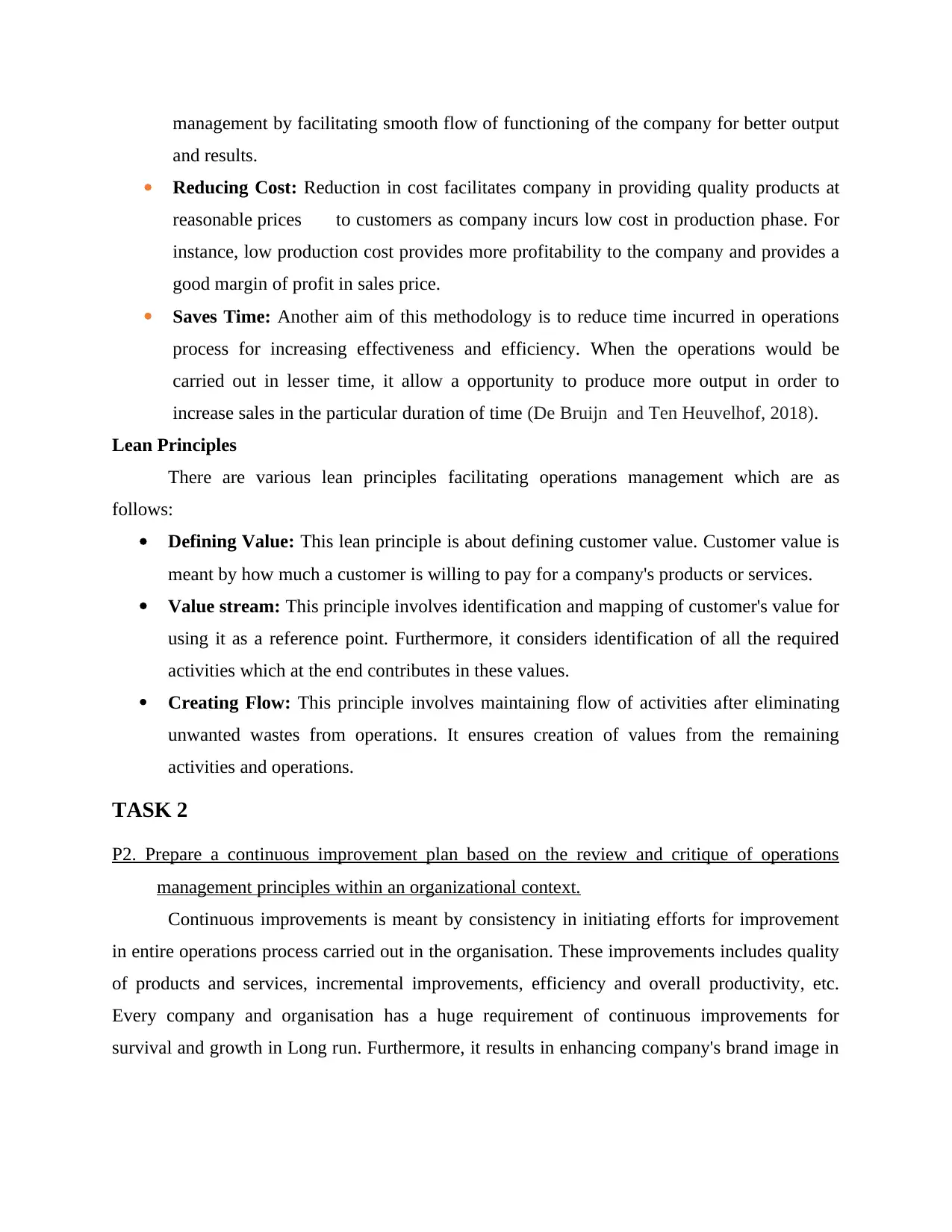
management by facilitating smooth flow of functioning of the company for better output
and results.
Reducing Cost: Reduction in cost facilitates company in providing quality products at
reasonable prices to customers as company incurs low cost in production phase. For
instance, low production cost provides more profitability to the company and provides a
good margin of profit in sales price.
Saves Time: Another aim of this methodology is to reduce time incurred in operations
process for increasing effectiveness and efficiency. When the operations would be
carried out in lesser time, it allow a opportunity to produce more output in order to
increase sales in the particular duration of time (De Bruijn and Ten Heuvelhof, 2018).
Lean Principles
There are various lean principles facilitating operations management which are as
follows:
Defining Value: This lean principle is about defining customer value. Customer value is
meant by how much a customer is willing to pay for a company's products or services.
Value stream: This principle involves identification and mapping of customer's value for
using it as a reference point. Furthermore, it considers identification of all the required
activities which at the end contributes in these values.
Creating Flow: This principle involves maintaining flow of activities after eliminating
unwanted wastes from operations. It ensures creation of values from the remaining
activities and operations.
TASK 2
P2. Prepare a continuous improvement plan based on the review and critique of operations
management principles within an organizational context.
Continuous improvements is meant by consistency in initiating efforts for improvement
in entire operations process carried out in the organisation. These improvements includes quality
of products and services, incremental improvements, efficiency and overall productivity, etc.
Every company and organisation has a huge requirement of continuous improvements for
survival and growth in Long run. Furthermore, it results in enhancing company's brand image in
and results.
Reducing Cost: Reduction in cost facilitates company in providing quality products at
reasonable prices to customers as company incurs low cost in production phase. For
instance, low production cost provides more profitability to the company and provides a
good margin of profit in sales price.
Saves Time: Another aim of this methodology is to reduce time incurred in operations
process for increasing effectiveness and efficiency. When the operations would be
carried out in lesser time, it allow a opportunity to produce more output in order to
increase sales in the particular duration of time (De Bruijn and Ten Heuvelhof, 2018).
Lean Principles
There are various lean principles facilitating operations management which are as
follows:
Defining Value: This lean principle is about defining customer value. Customer value is
meant by how much a customer is willing to pay for a company's products or services.
Value stream: This principle involves identification and mapping of customer's value for
using it as a reference point. Furthermore, it considers identification of all the required
activities which at the end contributes in these values.
Creating Flow: This principle involves maintaining flow of activities after eliminating
unwanted wastes from operations. It ensures creation of values from the remaining
activities and operations.
TASK 2
P2. Prepare a continuous improvement plan based on the review and critique of operations
management principles within an organizational context.
Continuous improvements is meant by consistency in initiating efforts for improvement
in entire operations process carried out in the organisation. These improvements includes quality
of products and services, incremental improvements, efficiency and overall productivity, etc.
Every company and organisation has a huge requirement of continuous improvements for
survival and growth in Long run. Furthermore, it results in enhancing company's brand image in
Paraphrase This Document
Need a fresh take? Get an instant paraphrase of this document with our AI Paraphraser
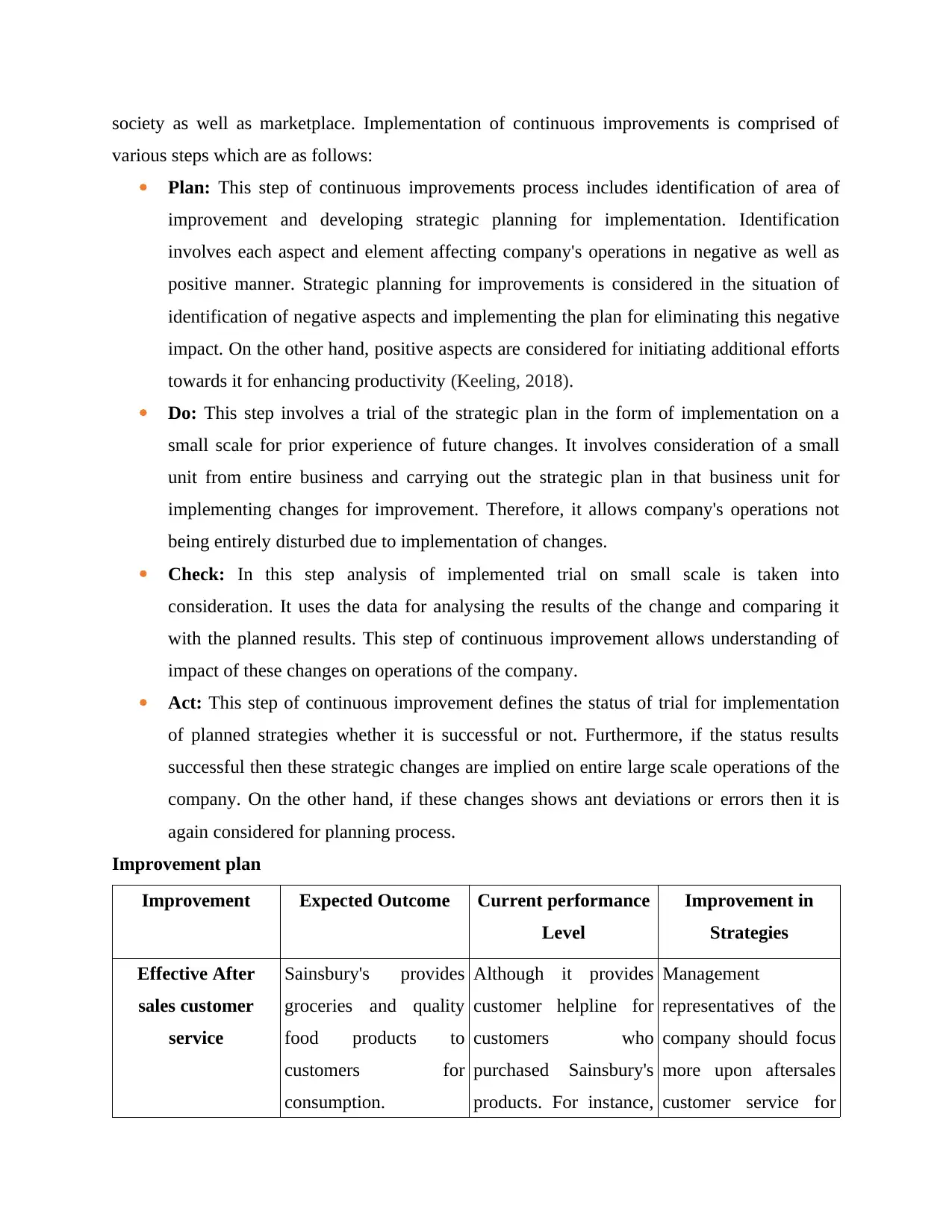
society as well as marketplace. Implementation of continuous improvements is comprised of
various steps which are as follows:
Plan: This step of continuous improvements process includes identification of area of
improvement and developing strategic planning for implementation. Identification
involves each aspect and element affecting company's operations in negative as well as
positive manner. Strategic planning for improvements is considered in the situation of
identification of negative aspects and implementing the plan for eliminating this negative
impact. On the other hand, positive aspects are considered for initiating additional efforts
towards it for enhancing productivity (Keeling, 2018).
Do: This step involves a trial of the strategic plan in the form of implementation on a
small scale for prior experience of future changes. It involves consideration of a small
unit from entire business and carrying out the strategic plan in that business unit for
implementing changes for improvement. Therefore, it allows company's operations not
being entirely disturbed due to implementation of changes.
Check: In this step analysis of implemented trial on small scale is taken into
consideration. It uses the data for analysing the results of the change and comparing it
with the planned results. This step of continuous improvement allows understanding of
impact of these changes on operations of the company.
Act: This step of continuous improvement defines the status of trial for implementation
of planned strategies whether it is successful or not. Furthermore, if the status results
successful then these strategic changes are implied on entire large scale operations of the
company. On the other hand, if these changes shows ant deviations or errors then it is
again considered for planning process.
Improvement plan
Improvement Expected Outcome Current performance
Level
Improvement in
Strategies
Effective After
sales customer
service
Sainsbury's provides
groceries and quality
food products to
customers for
consumption.
Although it provides
customer helpline for
customers who
purchased Sainsbury's
products. For instance,
Management
representatives of the
company should focus
more upon aftersales
customer service for
various steps which are as follows:
Plan: This step of continuous improvements process includes identification of area of
improvement and developing strategic planning for implementation. Identification
involves each aspect and element affecting company's operations in negative as well as
positive manner. Strategic planning for improvements is considered in the situation of
identification of negative aspects and implementing the plan for eliminating this negative
impact. On the other hand, positive aspects are considered for initiating additional efforts
towards it for enhancing productivity (Keeling, 2018).
Do: This step involves a trial of the strategic plan in the form of implementation on a
small scale for prior experience of future changes. It involves consideration of a small
unit from entire business and carrying out the strategic plan in that business unit for
implementing changes for improvement. Therefore, it allows company's operations not
being entirely disturbed due to implementation of changes.
Check: In this step analysis of implemented trial on small scale is taken into
consideration. It uses the data for analysing the results of the change and comparing it
with the planned results. This step of continuous improvement allows understanding of
impact of these changes on operations of the company.
Act: This step of continuous improvement defines the status of trial for implementation
of planned strategies whether it is successful or not. Furthermore, if the status results
successful then these strategic changes are implied on entire large scale operations of the
company. On the other hand, if these changes shows ant deviations or errors then it is
again considered for planning process.
Improvement plan
Improvement Expected Outcome Current performance
Level
Improvement in
Strategies
Effective After
sales customer
service
Sainsbury's provides
groceries and quality
food products to
customers for
consumption.
Although it provides
customer helpline for
customers who
purchased Sainsbury's
products. For instance,
Management
representatives of the
company should focus
more upon aftersales
customer service for
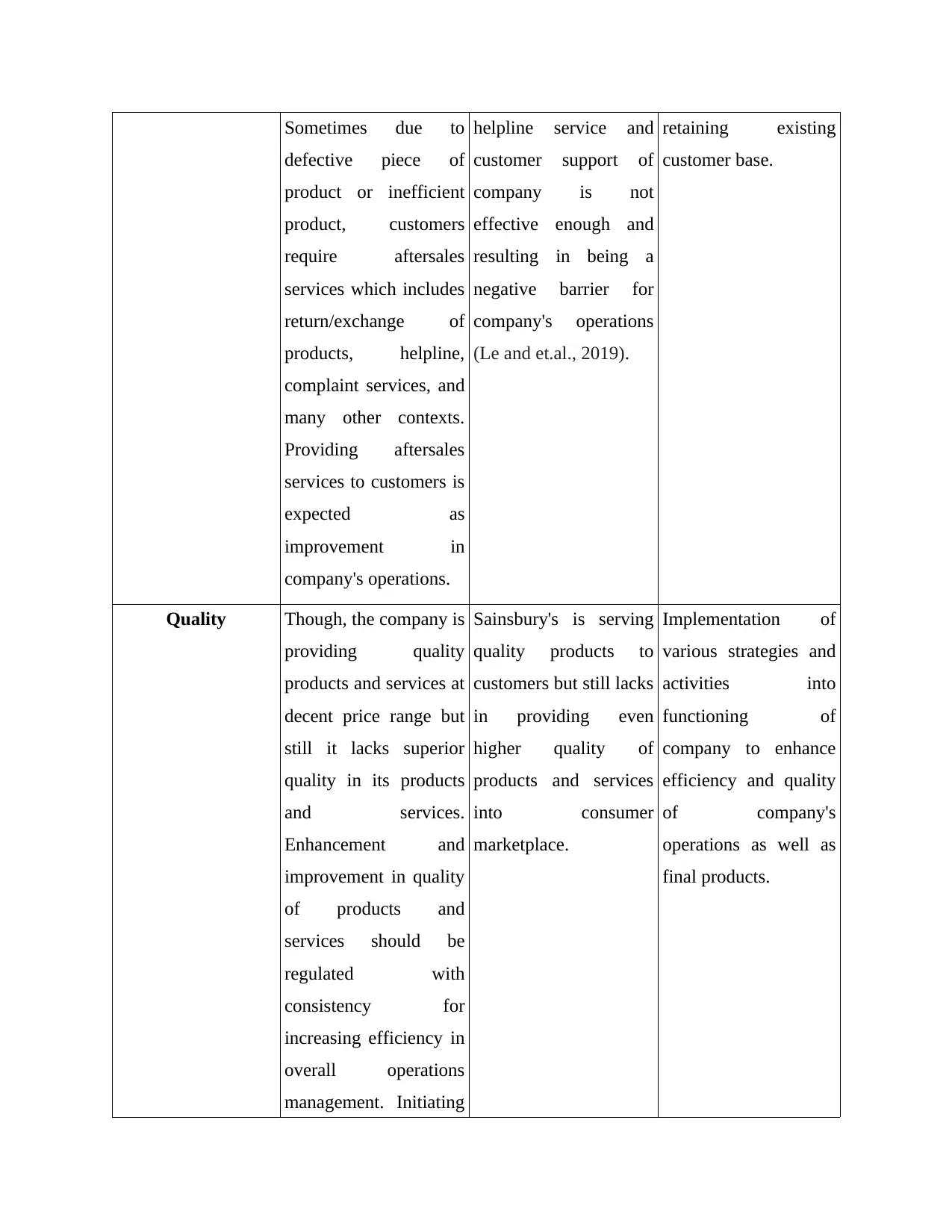
Sometimes due to
defective piece of
product or inefficient
product, customers
require aftersales
services which includes
return/exchange of
products, helpline,
complaint services, and
many other contexts.
Providing aftersales
services to customers is
expected as
improvement in
company's operations.
helpline service and
customer support of
company is not
effective enough and
resulting in being a
negative barrier for
company's operations
(Le and et.al., 2019).
retaining existing
customer base.
Quality Though, the company is
providing quality
products and services at
decent price range but
still it lacks superior
quality in its products
and services.
Enhancement and
improvement in quality
of products and
services should be
regulated with
consistency for
increasing efficiency in
overall operations
management. Initiating
Sainsbury's is serving
quality products to
customers but still lacks
in providing even
higher quality of
products and services
into consumer
marketplace.
Implementation of
various strategies and
activities into
functioning of
company to enhance
efficiency and quality
of company's
operations as well as
final products.
defective piece of
product or inefficient
product, customers
require aftersales
services which includes
return/exchange of
products, helpline,
complaint services, and
many other contexts.
Providing aftersales
services to customers is
expected as
improvement in
company's operations.
helpline service and
customer support of
company is not
effective enough and
resulting in being a
negative barrier for
company's operations
(Le and et.al., 2019).
retaining existing
customer base.
Quality Though, the company is
providing quality
products and services at
decent price range but
still it lacks superior
quality in its products
and services.
Enhancement and
improvement in quality
of products and
services should be
regulated with
consistency for
increasing efficiency in
overall operations
management. Initiating
Sainsbury's is serving
quality products to
customers but still lacks
in providing even
higher quality of
products and services
into consumer
marketplace.
Implementation of
various strategies and
activities into
functioning of
company to enhance
efficiency and quality
of company's
operations as well as
final products.
⊘ This is a preview!⊘
Do you want full access?
Subscribe today to unlock all pages.

Trusted by 1+ million students worldwide
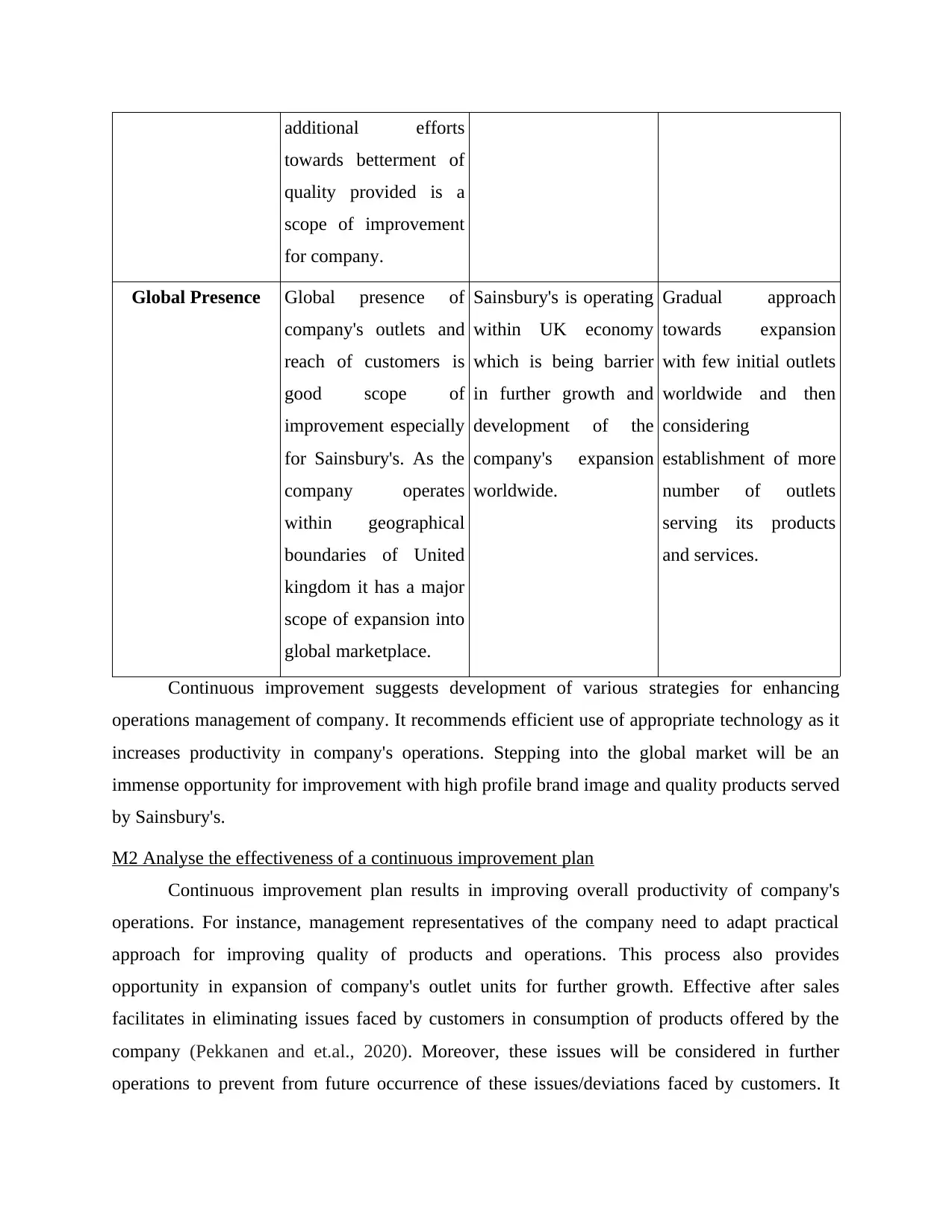
additional efforts
towards betterment of
quality provided is a
scope of improvement
for company.
Global Presence Global presence of
company's outlets and
reach of customers is
good scope of
improvement especially
for Sainsbury's. As the
company operates
within geographical
boundaries of United
kingdom it has a major
scope of expansion into
global marketplace.
Sainsbury's is operating
within UK economy
which is being barrier
in further growth and
development of the
company's expansion
worldwide.
Gradual approach
towards expansion
with few initial outlets
worldwide and then
considering
establishment of more
number of outlets
serving its products
and services.
Continuous improvement suggests development of various strategies for enhancing
operations management of company. It recommends efficient use of appropriate technology as it
increases productivity in company's operations. Stepping into the global market will be an
immense opportunity for improvement with high profile brand image and quality products served
by Sainsbury's.
M2 Analyse the effectiveness of a continuous improvement plan
Continuous improvement plan results in improving overall productivity of company's
operations. For instance, management representatives of the company need to adapt practical
approach for improving quality of products and operations. This process also provides
opportunity in expansion of company's outlet units for further growth. Effective after sales
facilitates in eliminating issues faced by customers in consumption of products offered by the
company (Pekkanen and et.al., 2020). Moreover, these issues will be considered in further
operations to prevent from future occurrence of these issues/deviations faced by customers. It
towards betterment of
quality provided is a
scope of improvement
for company.
Global Presence Global presence of
company's outlets and
reach of customers is
good scope of
improvement especially
for Sainsbury's. As the
company operates
within geographical
boundaries of United
kingdom it has a major
scope of expansion into
global marketplace.
Sainsbury's is operating
within UK economy
which is being barrier
in further growth and
development of the
company's expansion
worldwide.
Gradual approach
towards expansion
with few initial outlets
worldwide and then
considering
establishment of more
number of outlets
serving its products
and services.
Continuous improvement suggests development of various strategies for enhancing
operations management of company. It recommends efficient use of appropriate technology as it
increases productivity in company's operations. Stepping into the global market will be an
immense opportunity for improvement with high profile brand image and quality products served
by Sainsbury's.
M2 Analyse the effectiveness of a continuous improvement plan
Continuous improvement plan results in improving overall productivity of company's
operations. For instance, management representatives of the company need to adapt practical
approach for improving quality of products and operations. This process also provides
opportunity in expansion of company's outlet units for further growth. Effective after sales
facilitates in eliminating issues faced by customers in consumption of products offered by the
company (Pekkanen and et.al., 2020). Moreover, these issues will be considered in further
operations to prevent from future occurrence of these issues/deviations faced by customers. It
Paraphrase This Document
Need a fresh take? Get an instant paraphrase of this document with our AI Paraphraser
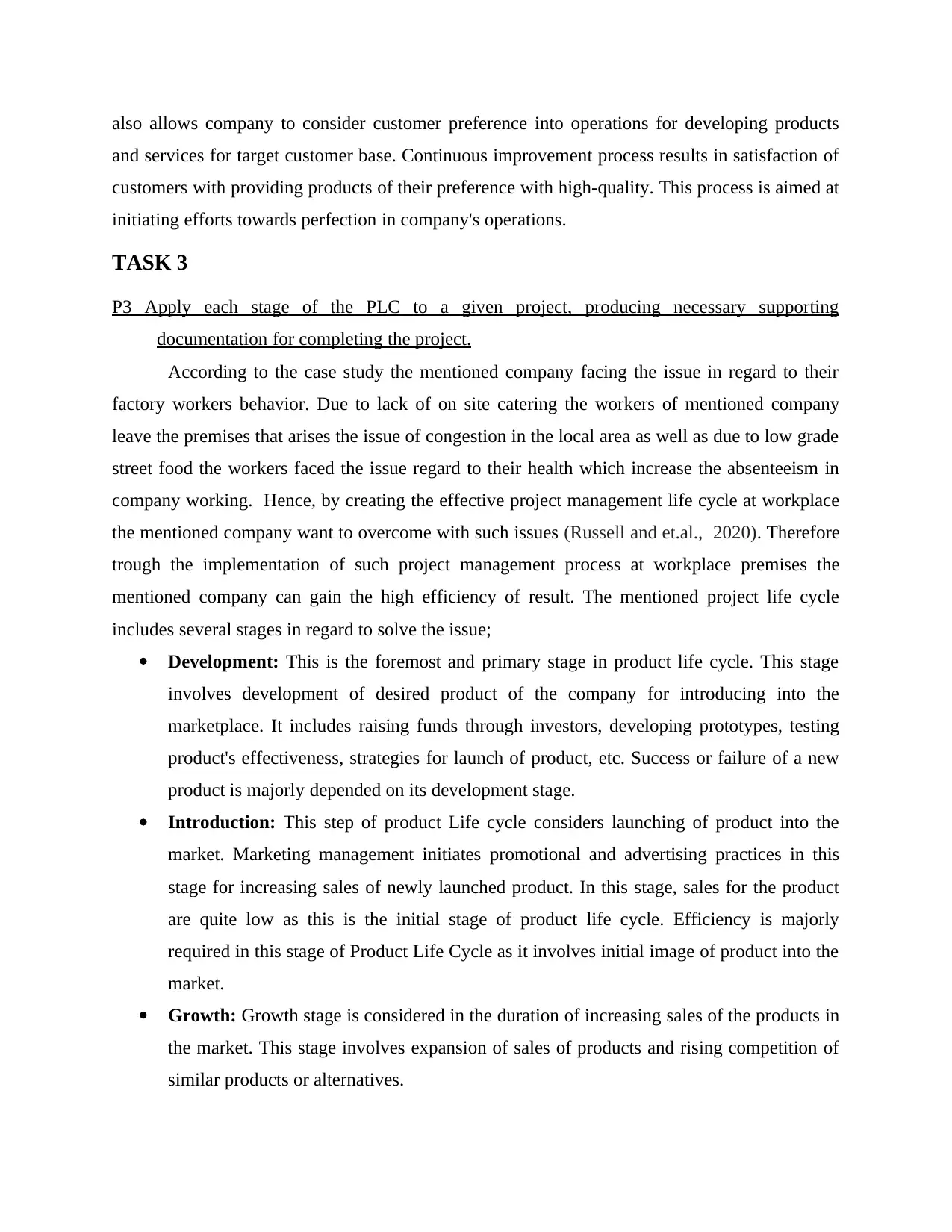
also allows company to consider customer preference into operations for developing products
and services for target customer base. Continuous improvement process results in satisfaction of
customers with providing products of their preference with high-quality. This process is aimed at
initiating efforts towards perfection in company's operations.
TASK 3
P3 Apply each stage of the PLC to a given project, producing necessary supporting
documentation for completing the project.
According to the case study the mentioned company facing the issue in regard to their
factory workers behavior. Due to lack of on site catering the workers of mentioned company
leave the premises that arises the issue of congestion in the local area as well as due to low grade
street food the workers faced the issue regard to their health which increase the absenteeism in
company working. Hence, by creating the effective project management life cycle at workplace
the mentioned company want to overcome with such issues (Russell and et.al., 2020). Therefore
trough the implementation of such project management process at workplace premises the
mentioned company can gain the high efficiency of result. The mentioned project life cycle
includes several stages in regard to solve the issue;
Development: This is the foremost and primary stage in product life cycle. This stage
involves development of desired product of the company for introducing into the
marketplace. It includes raising funds through investors, developing prototypes, testing
product's effectiveness, strategies for launch of product, etc. Success or failure of a new
product is majorly depended on its development stage.
Introduction: This step of product Life cycle considers launching of product into the
market. Marketing management initiates promotional and advertising practices in this
stage for increasing sales of newly launched product. In this stage, sales for the product
are quite low as this is the initial stage of product life cycle. Efficiency is majorly
required in this stage of Product Life Cycle as it involves initial image of product into the
market.
Growth: Growth stage is considered in the duration of increasing sales of the products in
the market. This stage involves expansion of sales of products and rising competition of
similar products or alternatives.
and services for target customer base. Continuous improvement process results in satisfaction of
customers with providing products of their preference with high-quality. This process is aimed at
initiating efforts towards perfection in company's operations.
TASK 3
P3 Apply each stage of the PLC to a given project, producing necessary supporting
documentation for completing the project.
According to the case study the mentioned company facing the issue in regard to their
factory workers behavior. Due to lack of on site catering the workers of mentioned company
leave the premises that arises the issue of congestion in the local area as well as due to low grade
street food the workers faced the issue regard to their health which increase the absenteeism in
company working. Hence, by creating the effective project management life cycle at workplace
the mentioned company want to overcome with such issues (Russell and et.al., 2020). Therefore
trough the implementation of such project management process at workplace premises the
mentioned company can gain the high efficiency of result. The mentioned project life cycle
includes several stages in regard to solve the issue;
Development: This is the foremost and primary stage in product life cycle. This stage
involves development of desired product of the company for introducing into the
marketplace. It includes raising funds through investors, developing prototypes, testing
product's effectiveness, strategies for launch of product, etc. Success or failure of a new
product is majorly depended on its development stage.
Introduction: This step of product Life cycle considers launching of product into the
market. Marketing management initiates promotional and advertising practices in this
stage for increasing sales of newly launched product. In this stage, sales for the product
are quite low as this is the initial stage of product life cycle. Efficiency is majorly
required in this stage of Product Life Cycle as it involves initial image of product into the
market.
Growth: Growth stage is considered in the duration of increasing sales of the products in
the market. This stage involves expansion of sales of products and rising competition of
similar products or alternatives.
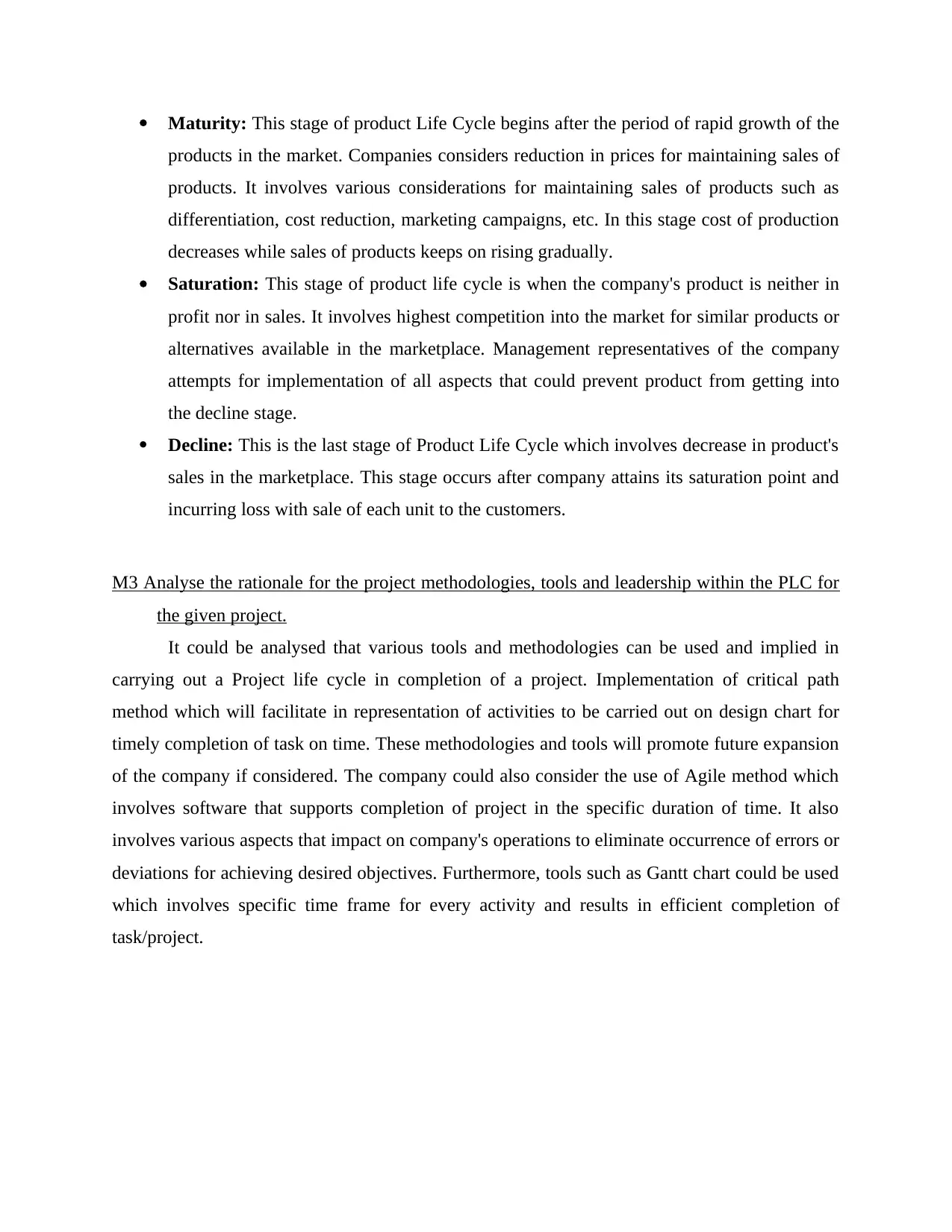
Maturity: This stage of product Life Cycle begins after the period of rapid growth of the
products in the market. Companies considers reduction in prices for maintaining sales of
products. It involves various considerations for maintaining sales of products such as
differentiation, cost reduction, marketing campaigns, etc. In this stage cost of production
decreases while sales of products keeps on rising gradually.
Saturation: This stage of product life cycle is when the company's product is neither in
profit nor in sales. It involves highest competition into the market for similar products or
alternatives available in the marketplace. Management representatives of the company
attempts for implementation of all aspects that could prevent product from getting into
the decline stage.
Decline: This is the last stage of Product Life Cycle which involves decrease in product's
sales in the marketplace. This stage occurs after company attains its saturation point and
incurring loss with sale of each unit to the customers.
M3 Analyse the rationale for the project methodologies, tools and leadership within the PLC for
the given project.
It could be analysed that various tools and methodologies can be used and implied in
carrying out a Project life cycle in completion of a project. Implementation of critical path
method which will facilitate in representation of activities to be carried out on design chart for
timely completion of task on time. These methodologies and tools will promote future expansion
of the company if considered. The company could also consider the use of Agile method which
involves software that supports completion of project in the specific duration of time. It also
involves various aspects that impact on company's operations to eliminate occurrence of errors or
deviations for achieving desired objectives. Furthermore, tools such as Gantt chart could be used
which involves specific time frame for every activity and results in efficient completion of
task/project.
products in the market. Companies considers reduction in prices for maintaining sales of
products. It involves various considerations for maintaining sales of products such as
differentiation, cost reduction, marketing campaigns, etc. In this stage cost of production
decreases while sales of products keeps on rising gradually.
Saturation: This stage of product life cycle is when the company's product is neither in
profit nor in sales. It involves highest competition into the market for similar products or
alternatives available in the marketplace. Management representatives of the company
attempts for implementation of all aspects that could prevent product from getting into
the decline stage.
Decline: This is the last stage of Product Life Cycle which involves decrease in product's
sales in the marketplace. This stage occurs after company attains its saturation point and
incurring loss with sale of each unit to the customers.
M3 Analyse the rationale for the project methodologies, tools and leadership within the PLC for
the given project.
It could be analysed that various tools and methodologies can be used and implied in
carrying out a Project life cycle in completion of a project. Implementation of critical path
method which will facilitate in representation of activities to be carried out on design chart for
timely completion of task on time. These methodologies and tools will promote future expansion
of the company if considered. The company could also consider the use of Agile method which
involves software that supports completion of project in the specific duration of time. It also
involves various aspects that impact on company's operations to eliminate occurrence of errors or
deviations for achieving desired objectives. Furthermore, tools such as Gantt chart could be used
which involves specific time frame for every activity and results in efficient completion of
task/project.
⊘ This is a preview!⊘
Do you want full access?
Subscribe today to unlock all pages.

Trusted by 1+ million students worldwide
1 out of 15
Related Documents
Your All-in-One AI-Powered Toolkit for Academic Success.
+13062052269
info@desklib.com
Available 24*7 on WhatsApp / Email
![[object Object]](/_next/static/media/star-bottom.7253800d.svg)
Unlock your academic potential
Copyright © 2020–2025 A2Z Services. All Rights Reserved. Developed and managed by ZUCOL.




